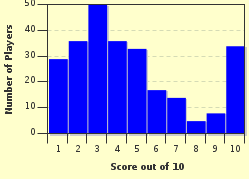Quiz Answer Key and Fun Facts
1. The easiest way to find direction at night in the Northern Hemisphere is to find Polaris, the North Star, since it always points due north. Besides finding north, what other critical information can be indicated by the angle of Polaris between the observer, the star, and the horizon?
2. During the day when the North Star is not visible, the Sun can be used to find direction. In the Northern Hemisphere, what direction is the Sun when it is at its highest point in the sky?
3. A common belief is that the Sun always rises due east, and sets due west. This is true for the equinoxes, however the further away you are from the vernal or autumnal equinox, the differences in location for sunrise and sunset increase. In June in the Northern Hemisphere, from what direction does the Sun rise?
4. When using the Sun, Moon, and stars to tell time, it is important to know the difference between solar and local time. The definition of solar noon is the time when the Sun is at its highest point in the sky. This time is approximately 12:00 pm, but a few factors can contribute to solar and local noon differing by up to an hour or two. When converting solar noon to the actual local time, which of the following factors in the least?
5. If lost in the wild, knowing the time to sunset can play an important role when deciding when to start preparing a shelter for the night. One method of estimating the time until sunset is the "four fingers" method. This method entails holding out your arm, and tilting your hand sideways, palm facing you. Line up the bottom of your little finger (digitus minimus) with the horizon below the Sun. Each finger width between the top of the Sun and the horizon represents fifteen-minute increments until sunset, and four fingers is an hour. If it is the afternoon, the Sun is "six fingers" above the horizon using the "four fingers" method, and sunset is around 6:00 pm, what is the approximate time?
6. If lost without a clock, the Moon can be a fantastic tool used to approximate the time of day. The phase of the moon can be used to indicate where the Sun is in relation to the Earth and Moon, and hence the solar time. For instance, a full moon is always highest in the sky at solar midnight, when the sun is directly behind the observer. By the same logic, a new moon is always highest in the sky at solar noon, although not visible. Halfway between a full moon and a new moon, a third quarter moon is highest at 6:00 am. Using this information, if the Moon is a waning gibbous and it is at its highest point in the southern sky, what is the approximate solar time?
7. If the Moon is a waxing crescent, and it is in its highest point in the southern sky, what is the approximate solar time?
8. The time the Moon takes to traverse the sky is dependent on its phase and time of year. If an observer is in a place where a day is 10 hours long in the winter and 14 hours long in the summer, a first quarter moon will be visible for 10 hours in the fall, and 14 hours in the spring. A first quarter moon is always highest in the sky at 6:00 pm solar time. If it is springtime for this observer, and a first quarter moon is eight finger widths above the eastern horizon using the "four fingers" method, what is the current solar time?
9. Since the Earth makes one rotation per day, the stars in the northern sky appear to make one rotation about the North Star each day. This can be a handy tool used to tell time, but it involves a bit of math using the "Big Dipper Clock." In the "Big Dipper Clock," imagine an inverted 24-hour clock centered around the North Star, moving counter-clockwise. For this clock, the normal 3:00 position is 6:00 pm, 12:00 is midnight, and the normal 9:00 position is 6:00 am. Every 30 degrees, an hour on a normal clock, represents two hours on the Big Dipper Clock. The "hour hand" in this case is the imaginary line drawn from the North Star to the two stars that make up the far edge of the "bowl" of the Big Dipper (Alpha Ursae Majoris and Beta Ursae Majoris). To account for the Earth's revolution around the Sun, add two hours for every month after March 7, or four minutes per day, and this is the current solar time. For example, if the "hour hand" is in the 2:00 position, that represents 8:00 pm on the "Big Dipper Clock." On March 7, it would be 8:00 pm and on May 7, it would be midnight solar time. If the hour hand of the Big Dipper Clock is facing the normal 11:00 position on April 7, what is the approximate solar time?
10. If the hour hand of the "Big Dipper Clock" is at a 45 degree angle between 9:00 and 12:00 on a normal clock, or the 10:30 position, and it is January 7th, what is the local solar time?
Source: Author
mcdubb
This quiz was reviewed by FunTrivia editor
Leau before going online.
Any errors found in FunTrivia content are routinely corrected through our feedback system.

